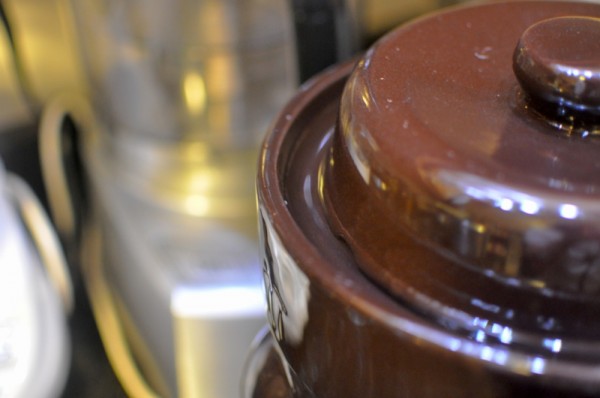Lindsay and I had a busy day. But we had a lot of help in the form of pressurized steam, yeast, and lactobacillus bacteria.
We’re leaving for Florida early this week and received a shocking amount of food from our CSA, considering it’s still the winter season and it was the second-to-last pickup. Four pounds of onions, four pounds of beets and radishes, five pounds of apples… you get the picture. We’ve certainly gotten our money’s worth this year! But with all this food on top of what we already had, we needed to prep some for storage.
To deal with the four pounds of fingerling potatoes (which we already had a bunch of), Lindsay used our pressure canner for the first time:
Regular water-bath canning limits you to recipes that are acidic or briny enough to kill off botulism. 212-degree boiling water will kill off everything else, but botulism can survive (see our rules of canning, which we will need to update to include a guide to pressure canning). Pressure canning uses pressure to get the temperature high enough to kill absolutely everything, which means that you can do absolutely anything you wants.
And it’s a two-fee: it cooks at the same time it preserves. In six months, if we want to make potato salad, we can just reach for one of these jars. Lindsay will have to write-up the process of pressure canning. Even though it was perfectly easy and safe, the first time is still scary and intimidating, even for someone comfortable with canning. Just look at this steampunk contraption:
Second, to deal with the two heads of cabbage we weren’t going to eat, Lindsay made (actually, is still in the process of making) sauerkraut. Our CSA this year has given us a lot of cabbage (both red and green), and we’ve found that we waste a lot less of it by taking an hour to make one large batch of kraut which will supply 5-10 quick dinners down the line. We even decided to invest in a ceramic fermenting crock that has a water moat to allow it to “burp” while fermenting while still enduring that no nasty microbes can get in:
Finally, speaking of fermenting, I made a batch of beer this weekend. I plan to take more photos down the line and do a real post once I get the hang of the process, but for now, here’s a preview:
It is an all-grain (from malted barley) recipe and we decided to save the “spent grain” that is left over. This grain has been crushed and steeped in hot water to convert and extract all the sugar from the starches, but what’s left over still has flavor. We used our dehydrator to dry it out so that we can store it. It goes great as an added crunch to granola (reminds me of grape nuts) and we also plan to crush it into flour and make some spent-grain baked goods:





